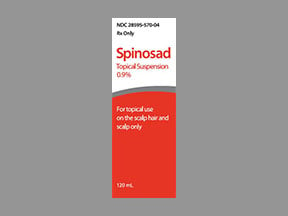
Spinosad Coupons & Savings Card – Discount Prices from $121.38
Generic for: Natroba
My prescription
Edit
120ML of 0.9%, Spinosad (1 Bottle)
Select pharmacy

CVS
$263.14
COUPON PRICE
Walgreens
$121.38
COUPON PRICE
Albertsons
$237.60
COUPON PRICE
Walmart
$255.47
COUPON PRICESpinosad savings card
Show this card to your pharmacist
Walgreens
$121.38
BIN
ID
PCN
GRP
015995
LHFA016289
GDC
GDRX
Powered by
More prescriptions for scabies
More prescriptions for scabies
Price history for Natroba (brand) & Spinosad (generic)
1 Bottle, 120ML of 0.9%
Average retail price for Natroba
Average retail price for Spinosad
Average SaveHealth price for Spinosad
Our price history data is based on aggregated prescription data collected from participating pharmacies in America. Our prescription data updates daily to reflect the latest price changes. If you notice a missing data point, it means there wasn't sufficient data available to generate a monetary value for that date.
We analyzed Spinosad prices for (120ML of 0.9%, 1 Bottle) over the last 12 months. The average retail price was $955.00, while the average price using the SaveHealth discount card was $355.01. That's a savings of approximately 62.83% when using our Spinosad coupon.
Compared to the generic version, Natroba had an average price of $362.64 over the same time period. With the SaveHealth savings card, Spinosad is 2.10% cheaper on average than Natroba.
*Retail prices are based on pharmacy claims data, and may not be accurate when we don't have enough claims.
Spinosad dosage forms
Dosage Quantity Price from Per unit 120ML of 0.9% 1 Bottle $255.47 $255.47 120ML of 0.9% 2 Bottles $529.92 $264.96 120ML of 0.9% 3 Bottles $804.38 $268.13
| Dosage | Quantity | Price from | Per unit |
|---|---|---|---|
| 120ML of 0.9% | 1 Bottle | $255.47 | $255.47 |
| 120ML of 0.9% | 2 Bottles | $529.92 | $264.96 |
| 120ML of 0.9% | 3 Bottles | $804.38 | $268.13 |
Spinosad Warnings
Spinosad is a naturally derived insecticide widely used in agriculture and for treating head lice. While it is generally considered safe when used as directed, certain risks are associated with its use.
Potential Health Risks:
Reproductive Concerns: Animal studies have indicated that spinosad may affect fertility. In a two-generation reproductive toxicity study in rats, reduced fertility indices and complications during childbirth were observed. Consequently, spinosad has been proposed for classification as a substance suspected of damaging fertility.
Organ Damage from Prolonged Exposure: Long-term exposure to spinosad has been linked to organ damage. In a one-year neurotoxicity study in rats, degeneration of the trigeminal ganglion was noted at certain exposure levels. This has led to proposals for classifying spinosad as a substance that may cause organ damage through prolonged or repeated exposure.
Environmental Considerations:
- Impact on Pollinators: Spinosad is highly toxic to honeybees if they come into direct contact with it. However, studies have shown that once spinosad residues have dried on plant foliage (typically within three hours), the risk to honeybees becomes negligible. To protect pollinators, it is advisable to apply spinosad during times when bees are less active, such as early morning or late evening, and to avoid spraying directly on blooming plants.
Safety Precautions:
Protective Measures: When handling or applying spinosad, wear appropriate protective clothing, including long-sleeved shirts, long pants, chemical-resistant gloves, socks, and closed-toe shoes. This minimizes the risk of skin contact and potential absorption of the insecticide.
Avoiding Eye and Skin Contact: Spinosad can cause irritation upon contact with skin or eyes. If accidental contact occurs, rinse the affected area with plenty of water. In case of eye exposure, flush the eyes with water for at least 15 minutes and seek medical attention if irritation persists.
Proper Storage and Disposal: Store spinosad products in their original containers in a cool, dry, and well-ventilated area, away from children, pets, food, and feed products. Follow the product label instructions for proper disposal to prevent environmental contamination.
By adhering to these guidelines and using spinosad responsibly, users can mitigate potential risks to human health and the environment.
Spinosad Side Effects
Common side effects:
- Redness on the scalp
- Irritation at the application site
- Eye redness
- Dry skin
Less common but important to monitor:
- Hair loss
Serious side effects:
- Rash
- Itching or swelling (particularly of the face, tongue, or throat)
- Severe dizziness
- Difficulty breathing
Spinosad Interactions
Spinosad is an insecticide commonly used in veterinary medicine to control flea infestations in dogs and cats. While generally safe, it's important to be aware of potential interactions with other medications that could affect your pet's health.
One notable interaction occurs between spinosad and Ivermectin, a medication often used to prevent heartworm disease and treat certain parasites. When administered together, spinosad can inhibit a protein called P-glycoprotein (P-gp), which plays a role in drug transport within the body. This inhibition can lead to increased levels of ivermectin in the bloodstream, potentially causing neurological side effects such as tremors, ataxia (loss of coordination), and lethargy. These effects are more likely when high doses of ivermectin are used, as in the treatment of conditions like demodectic mange. However, the low doses of ivermectin found in standard heartworm preventatives are generally considered safe when used with spinosad.
Another interaction to consider is between spinosad and milbemycin oxime, another antiparasitic agent. There have been reports of adverse reactions, including neurological signs like ataxia and tremors, in pets receiving both medications concurrently. While such cases are relatively rare, they highlight the importance of cautious use when combining these treatments.
Additionally, spinosad may interact with other drugs that are substrates of P-glycoprotein, such as Cyclosporine, Ketoconazole, and Loperamide. These interactions can alter the effectiveness of the medications or increase the risk of side effects.
Given these potential interactions, it's crucial to inform your veterinarian about all medications, supplements, and herbal products your pet is currently receiving before starting spinosad. This will help ensure the safe and effective use of the treatment tailored to your pet's specific needs.
